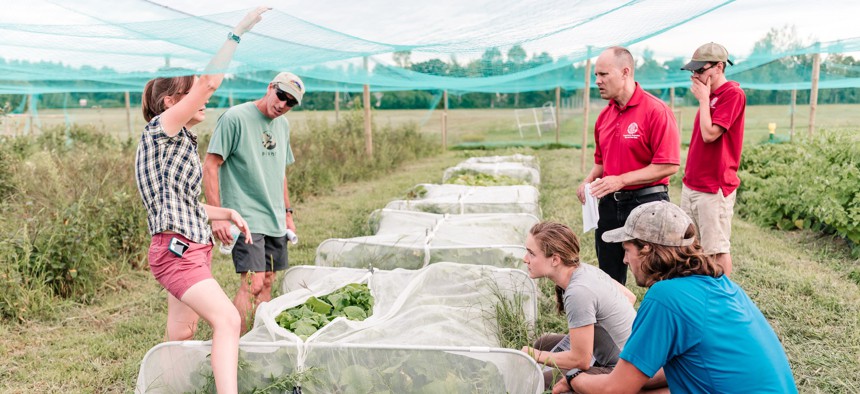A drought hit the Finger Lakes region several years ago, right as Scott Osborn was testing a new product on the crops in his vineyards. He sprayed the product, which contained a type of fungus meant to form mutually beneficial relationships with grapevines, on six rows of vines that had fared poorly during a similar drought the previous year. The leaves on those six rows of vines managed to stay green despite the drought. Meanwhile, the untreated vines next to them began to lose their leaves.
“There was something going on here that I didn’t understand,” said Osborn, the president and co-owner of Fox Run Vineyards. He turned to Justine Vanden Heuvel, a professor at the Cornell University College of Agriculture and Life Sciences, to see whether she might be able to look into the use of such fungi. Vanden Heuvel asked Osborn to gather a group of growers who might be interested in testing it, and she applied for research funding and took on the project – which emerged with promising results.
This project illustrated how Cornell University, a land-grant institution, has played a key role in bolstering New York’s agricultural sector. Beyond agricultural research, the university works on numerous programs and initiatives with local farmers to develop new technology and practices. That work is fueled by approximately $334 million from federal, state and corporate sources that has been spent locally in New York.
The Morrill Land Grant College Act, passed amid the Civil War in 1862, allowed states to create new agricultural and engineering schools using proceeds from selling federal land largely taken from Indigenous people. The formation of these land-grant institutions fueled Cornell University’s creation in 1865.
Subsequent legislation established new agricultural experiment stations, which supported research into food production at these universities. By 1914, the federal government also had enacted a new law funding a service that had land-grant universities disseminate their agricultural research to the broader population of rural Americans. Land-grant universities continue to exist in each state, with Cornell – a rare example of a private land-grant university – as the only one in New York.
Cornell’s role in producing research and sharing it with the public stems from this history and continues in the 21st century. The university hosts two federally funded research sites, for example: the Cornell University Agricultural Experiment Station and Cornell AgriTech. Cornell’s Cooperative Extension system, which connects its research to local communities, has a presence in each county in New York state. The extension system reaches about 1.7 million New Yorkers each year, according to the university. Collectively, this means that Cornell plays a notable role in supporting and growing the state’s agricultural industry.
Former state Sen. Catharine Young leads one of Cornell’s initiatives to connect with the broader agricultural community as executive director of the New York State Center of Excellence for Food and Agriculture at Cornell AgriTech. In this role, she leads efforts to draw entrepreneurs and startups focused on food and agriculture to New York and helps grow existing businesses in the state. The center currently works with about 200 clients, according to Young, who drafted agriculture legislation during her time in elected office.
“The way that we do it is through a variety of methods,” she said. “It’s connecting with – if it’s appropriate – Cornell research, innovation and technology. It may be business mentoring. And we review pitch decks or business plans, business-to-business partnerships.”
Megan Méza is one business owner who said she benefited from working with Cornell. She founded Bandida, a company selling a version of horchata mixed with cold brew coffee, two years ago and has communicated with Cornell’s experts over the course of about a year and a half. With their help, Méza tested her recipe in a pilot plant and produced more than 500 bottles that she was then able to send out as samples to distributors and customers. They also helped guide her submission for a pitch competition for entrepreneurs, which she won, netting her business $20,000.
“I always feel like I would not be where I am today without Cornell,” she said.
The Cornell Cooperative Extension encompasses a significant portion of the university’s outreach efforts. One example of how the extension engages with the agricultural industry is through its workforce development program led by Richard Stup. He coordinates with the extension’s educators – who communicate with farmers on the ground – as well as farm management professionals, associations and other people in agribusiness to provide guidance on management, compliance and developing the agricultural workforce. For the past year and a half, that’s also meant a lot of support on developing guidelines to prevent the spread of COVID-19 and encouraging workers to get vaccinated.
“All of us at Cornell, and especially the extension, worked extra, extra overtime to help the industry adapt to be able to manage COVID,” Stup said.
Cornell University’s research and outreach will continue to carry weight in New York and often beyond. “The impact that they do locally, in many cases, is carried around the world,” Osborn said.
NEXT STORY: Will Kathy Hochul support a carbon tax?


